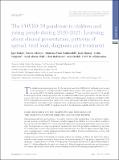Files in this item
The COVID-19 pandemic in children and young people during 2020-2021 : learning about clinical presentation, patterns of spread, viral load, diagnosis and treatment
Item metadata
| dc.contributor.author | Rudan, Igor | |
| dc.contributor.author | Adeloye, Davies | |
| dc.contributor.author | Katikireddi, Srinivasa Vittal | |
| dc.contributor.author | Murray, Josie | |
| dc.contributor.author | Simpson, Colin | |
| dc.contributor.author | Shah, Syed Ahmar | |
| dc.contributor.author | Robertson, Chris | |
| dc.contributor.author | Sheikh, Aziz | |
| dc.contributor.author | EAVE II collaboration | |
| dc.date.accessioned | 2022-08-04T16:30:01Z | |
| dc.date.available | 2022-08-04T16:30:01Z | |
| dc.date.issued | 2021-12-25 | |
| dc.identifier | 280689924 | |
| dc.identifier | 18602514-b0ce-4894-a8e9-06f95e16256d | |
| dc.identifier | 85123672649 | |
| dc.identifier | 35047182 | |
| dc.identifier.citation | Rudan , I , Adeloye , D , Katikireddi , S V , Murray , J , Simpson , C , Shah , S A , Robertson , C , Sheikh , A & EAVE II collaboration 2021 , ' The COVID-19 pandemic in children and young people during 2020-2021 : learning about clinical presentation, patterns of spread, viral load, diagnosis and treatment ' , Journal of Global Health , vol. 11 , 01010 . https://doi.org/10.7189/JOGH.11.01010 | en |
| dc.identifier.issn | 2047-2978 | |
| dc.identifier.other | PubMedCentral: PMC8763336 | |
| dc.identifier.other | ORCID: /0000-0002-1511-7944/work/116910275 | |
| dc.identifier.uri | https://hdl.handle.net/10023/25775 | |
| dc.description | Funding: EAVE II is funded by the Medical Research Council (MR/R008345/1) with the support of BREATHE - The Health Data Research Hub for Respiratory Health [MC_PC_19004], which is funded through the UK Research and Innovation Industrial Strategy Challenge Fund and delivered through Health Data Research UK. Additional support has been provided through Public Health Scotland and Scottish Government DG Health and Social Care.). SVK acknowledges funding from a NRS Senior Clinical Fellowship (SCAF/15/02), the Medical Research Council (MC_UU_00022/2) and the Scottish Government Chief Scientist Office (SPHSU17). | en |
| dc.description.abstract | The initial research questions posed by the scientists faced with SARS-CoV-2 outbreaks were focused on documenting the clinical presentation and the characteristics of the spread of the SARS-CoV-2 virus among CYP [1-3], and the optimal ways to diagnose CYP and treat those in need [1,4]. It quickly became apparent that younger age groups have a considerably milder clinical presentation, but also that they can very rarely develop a considerably more serious Multisystem Inflammatory Syndrome in Children (MISC) [1]. A special interest arose in how best to protect those particularly vulnerable. In this Editorial, we discuss the development of scientific evidence related to those research questions in children and young people during the first two years of the COVID-19 pandemic, based on the information available until December 1st, 2021 | |
| dc.format.extent | 16 | |
| dc.format.extent | 901659 | |
| dc.language.iso | eng | |
| dc.relation.ispartof | Journal of Global Health | en |
| dc.subject | COVID-19 | en |
| dc.subject | RA0421 Public health. Hygiene. Preventive Medicine | en |
| dc.subject | Health Policy | en |
| dc.subject | Public Health, Environmental and Occupational Health | en |
| dc.subject | 3rd-DAS | en |
| dc.subject | SDG 3 - Good Health and Well-being | en |
| dc.subject | NIS | en |
| dc.subject.lcc | RA0421 | en |
| dc.title | The COVID-19 pandemic in children and young people during 2020-2021 : learning about clinical presentation, patterns of spread, viral load, diagnosis and treatment | en |
| dc.type | Journal item | en |
| dc.contributor.institution | University of St Andrews. School of Medicine | en |
| dc.contributor.institution | University of St Andrews. Education Division | en |
| dc.identifier.doi | https://doi.org/10.7189/JOGH.11.01010 | |
| dc.description.status | Peer reviewed | en |
| dc.identifier.url | https://jogh.org/2021/jogh-11-01010 | en |
This item appears in the following Collection(s)
Items in the St Andrews Research Repository are protected by copyright, with all rights reserved, unless otherwise indicated.

